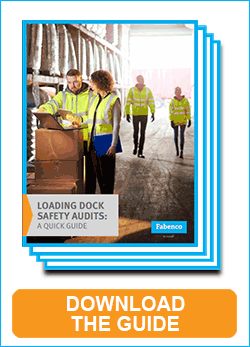
The rise of e-commerce has changed the face of logistics. Increased demand for fast delivery has led to the need for more last-minute warehousing and distribution facilities. In this fast-paced environment, it’s essential that safety protocols are in place and enforced and that the proper fall protection devices are installed. But where should you focus your attention to ensure that your last mile facility is compliant with OSHA regulations and safe for your workers?
Loading Dock Safety

- Painting the edge of the loading dock with a highly visible color.
- Installing a loading dock safety gate.
- Ensuring the loading dock is properly lit.
- Posting fall hazard warning signs and lights.
- Keeping the loading dock clear of debris, ice-free, and dry.
Warehouse Facility Fall Protection
In order to fully protect workers from falls within your facility, it’s vital that you perform a thorough safety inspection. Some of the areas you should pay particular attention to include elevated work surfaces and walkways, mezzanines, and any area where there’s an elevation change. Specific fall protection that needs to be in place to remain OSHA-compliant include:
Guardrails Around Elevated Surfaces
Anytime workers have to perform their duties at a height of 4 feet or more, you need to have guardrails installed around the work surface that are made of durable materials like steel or fiberglass. These guardrails have to be 42 inches (+ or – 3 inches) above the walking/working surface, made of durable material, free of snags, and capable of handling 200 pounds of concentrated force.
Gates to Protect Hazardous Areas
OSHA recommends using a self closing gate, metal swing gates, or a mezzanine gate where applicable, referring to them as possible ways to mitigate fall hazards. Should you choose to install a safety gate, be aware that they must meet the same criteria as guardrails. In addition, the gate must swing away from the hole or opening, and it must be offset to keep workers from directly walking into a hazard.
Fall Protection on Stairways
Internal stairways are among the areas where trip hazards are most common in last-mile facilities. This is especially true in a busy warehouse with many employees who must travel from one area to another frequently. Making sure stairways are equipped with proper handrails, that stairs are marked with bright tape or paint, that there’s adequate lighting, and keeping the area clean and dry will all mitigate fall hazards.
Ladder Fall Protection
If employees have to climb and descend ladders, pay close attention to OSHA’s guidelines for fall protection. The most important aspect of a ladder is that it is strong enough to withstand the weight it will encounter. It has to be finished in such a way that it can’t snag clothing, or injury employees. Fixed ladders may require a cage, guardrails and a swing gate, and workers may need to use a self-retracting lifeline in certain cases.
Personal Fall Protection Devices
In areas of your facility that aren’t suitable for a guardrail, or where metal swing gates or a self closing gate aren’t feasible, you need to provide your employees with personal protective equipment (PPE). This can include items such as a harness, safety lanyard, or self-retracting lifeline. Whatever personal fall protection devices you provide, it’s your responsibility to make sure they meet the OSHA compliance guidelines.
Organization and Cleanliness Matters
Chaos isn’t a good thing in a last-mile facility. Quite the opposite, in fact. The more organized and clean your facility is, the safer it is for everyone. Keeping walkways free of debris, tools, equipment, and other obstructions is a must. To avoid slip and fall accidents, keep floors dry and clean at all times. Make sure product, materials, and other supplies are secured properly. Overall, practice good housekeeping.
Employee Fall Safety Training
The best protection against falls in any last mile facility are well-trained, safety-aware employees. It’s your duty to provide every worker with a written copy of your specific fall protection policies. It’s also up to you to make sure that every employee understands your policies and follows all safety procedures properly. For that, you need a training program in place for new employees and follow-up training for all employees regularly.
Protect Your Equipment and Machines
In addition to protecting workers from falling from elevation, you also have to keep them safe from equipment and machinery. This is especially true when they have to use walkways, mezzanines, or other surfaces located above dangerous machines. Again, an OSHA-compliant guardrail with metal swing gates or a self closing gate is necessary at these elevated areas. They may also be used to protect the area around the equipment.
Make Fall Protection a Priority in Your Facility
You know that it’s your legal responsibility to provide your employees with a safe work environment and that you’re obligated to follow OSHA’s workplace regulations. But more importantly, you owe it to your workers because they are your single biggest asset. Make fall protection your top priority by installing adequate fall protection throughout the facility and provide your people with the Personal Protective Equipment they need.
Get the Right Fall Protection
Keeping your facility safe and OSHA-compliant is no easy task, but it’s imperative. Fall protection begins with installing passive fall protection devices like a metal guardrail, metal swing gates, a self-closing gate, and loading dock safety equipment. In some cases, you may need to add PPE to the mix to ensure workers are completely protected.




